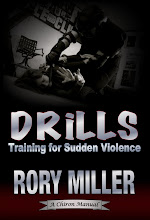It's not even a disagreement and this is one thing (among many) that you really must understand in order to teach self-defense. And I need to look at it harder as well. I don't just teach a homogenous group (officers) any more. I teach different people, many different people and each have skills and weaknesses, strengths as well as training holes.
Generally, I need to teach people to break eye contact. Generally, CC needs to teach people to make eye contact.
CC teaches a wide variety of people. Rank beginner up to some pretty specialized groups. Teaching beginners, you have to break down a lot of conditioning. Years and decades of being told not to be rude. Don't swear, don't spit, don't use nasty words and don't touch people inappropriately. Almost everything that falls under the umbrella of self-defense is rude. Injuring people is very inappropriate physical contact. Setting boundaries is yelling at strangers. CC notices, "How can you hit someone if you can't even look him in the eye?" Perfectly valid. Very true.
My usual student profile is very different. The people who train with me tend to be experienced martial artists who are just realizing how little they know of violence. One of the biggest hurdles to get them through is to break them of the habit of trying to win a game. Most are trying to dominate an opponent, not neutralize a threat. They fight, and fighting is extremely inefficient. Taking a threat down-- whether deadly force or handcuffing or shoving to escape-- can be extremely efficient. Because you don't care, it is just a job. I know I have written it before, but there is a qualitative difference between the way a farmer butchers a hog and the way the same farmer will fight a person.
- You don't need to get angry
- You have a reason, you don't need a justification (you don't need to feel that it is a 'bad hog')
- You don't give it a chance
- You never let it be a fight
- You are not trying to teach the hog a lesson
- It is not a form of communication
You can bypass all this stuff with humans, just like with animals-- and it doesn't have to be lethal. Simply efficient. But most can't because we are so wired to treat interpersonal violence as some form of dominance game or rules enforcement. It becomes about messages.
Because it is about communication, it is inherently inefficient at simply removing the threat. If you have trained hard for years at a system of fighting, it probably hurts your feelings and threatens your identity that I call it inefficient. I'm sorry for that, but the message is no less true and no less important-- pick the scariest baddest martial artist in the world. Could you beat him in a fight? Probably not. Could you incapacitate him in under a second (more, with set-up time)? If you can't, that is a failure of either imagination or understanding, having your brain locked into the irrational belief that fighting and removing a threat are the same thing. If they are on the same continuum, you may be missing some huge truths.
So for my student profile, breaking eye contact is a first step to making this transition. For CC, making and maintaining eye contact is a first step to being able to fight. For people who have fought for a long time, breaking eye contact is a first step to another level.
It's not just here, and I have to be careful. When I am teaching to one student or one group of students, the message may be entirely wrong for a different group, and they may be in the same class. The class last night, this morning and the one coming up in thirty minutes are 80% female. A lot of the material, particularly on adrenaline effects, are different for men than for women. Usually, I teach the male effects and then the female differences as a coda. (And had a great example of it after scenarios earlier today.) For this population, I should do it the other way. But it is hard to remember.
Different people need to be taught different things. It is getting more and more obvious that in this field you must teach the student, not the subject matter.


